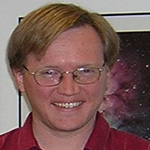Seminars are held at 4:00 PM on Tuesdays in Room F160
on the first floor of the Technological Institute (2145 Sheridan Road) unless otherwise noted
Winter Quarter 2012
| Date | Visitor / Seminar | Host | |
| Jan. 17 |  |
Thiem Hoang Precision cosmology missions are expected to answer crucial questions on the early Universe, provided that we understand CMB foregrounds properly. The electric dipole emission from spinning dust grains was identified by Draine & Lazarian (1998, namely DL98 model) as the source of the anomalous microwave emission, and this component of the Galactic foregrounds has became a focus of studies of many groups. In spite of its success, the DL98 model has a number of simplifying assumptions, which should be lifted to confront the high precision measurements by Planck satellite. In this talk, I will present our improved model of spinning dust emission. In particular, I will discuss the effects of "irregular" shape of grains, their thermal wobbling, and compressible turbulence on spinning dust emission. I will compare our improved spinning dust model with WMAP results, and discuss how our model can be used to constrain the physical properties of dust in the interstellar medium. | Giles Novak |
| Jan. 31 |  |
Kaitlin Kratter Binary and multiple stellar systems are common outcomes of the star formation process. More importantly, multiple systems contribute disproportionately to our understanding of topics ranging from stellar structure to cosmology. In this talk I will describe several theories for binary and multiple star formation, focusing on the role of protostellar accretion disks. I show that two modes of binary formation can account for the dependence of the observed binary fraction on stellar mass. Next, I will examine the long term stability of hierarchical stellar and planetary systems. I describe how mass loss due to stellar evolution can trigger orbital instabilities in such systems. These instabilities can produce odd-ball evolved binaries, frequent stellar collisions, and planets on eccentric orbits around evolved stars. |
Yoram Lithwick |
| Feb. 7 |
 |
Ted von Hippel In the 1960's stars were observed with single-channel photometers or worse, stellar evolution codes were run on a computer that barely bested a slide rule, and the results were compared by eye. While the observations and stellar models have improved tremendously in the interim, the methods by which we compare stellar models to data generally have not. I will describe a new Bayesian approach to this problem. Our Bayesian technique yields better precision in the ages, distances, etc. for stars and clusters, provides a fuller understanding of errors and correlations among the derived parameters, and allows us to attack a range of problems in stellar evolution in a consistent manner for the first time. |
Aaron Geller |
| Feb. 14 |
 |
Claire Max Adaptive optics is a technology that can remove the blurring effects of turbulence in the earth's atmosphere, so that telescopes on the ground can "see" as clearly as if they were in space. I will describe the basic principles of adaptive optics, and illustrate why lasers are needed to increase the fraction of the sky where one can apply adaptive optics corrections. As an example of astronomical observations which have benefitted strongly from adaptive optics correction. I will describe our recent detections and confirmations of dual supermassive black holes in colliding galaxies. | Aaron Geller |
| Feb. 28 |  |
Craig Heinke Massive stars explode as supernovae at the end of their lives, leaving neutron stars, dense balls of matter at super-nuclear density. The behavior of matter at such high density is not well understood. X-ray observations of hot young neutron stars are one method of probing the physics of neutron stars. I will discuss X-ray observations of some young neutron stars, focusing on the youngest known neutron star, in Cassiopeia A. Our team proposed that its unusual X-ray properties are naturally explained by a carbon atmosphere, and discovered that its surface is measurably cooling with time. The observed rate of cooling, and its current temperature, require a rapid, short-lived transition in the neutron star's interior. Our proposed explanation is that the neutrons in the core are undergoing a transition to a superfluid state, radiating away their heat via neutrinos as the neutrons pair up. |
Farhad Zadeh Aaron Geller |
| March 6 |  |
Ranga-Ram Chary The reionization of the intergalactic medium about a billion years after the Big Bang was an important event which occurred due to the release of ionizing photons from the growth of stellar mass and black holes in the early Universe. By leveraging the benefits of field galaxy surveys, I will present some recent breakthroughs in our understanding of how the earliest galaxies in the Universe evolved. I will present evidence that unlike in the local Universe where galaxy growth occurs through intermittent cannibalism, star-formation in the distant Universe is a more continuous if violent process with an overabundance of massive stars. Implications for the reionization history of the Universe will also be discussed. |
Mel Ulmer |
| March 13 |  |
Cecilia R. Aragon Many of today's important scientific breakthroughs are made by large, interdisciplinary collaborations of scientists working in geographically distributed locations, collecting, producing, and analyzing vast and complex data sets. This deluge of scientific data has been called the "data tsunami." Large-scale science projects require software tools that support, not only insight into exponentially growing data, but collaborative science discovery.
|
* CIERA Colloquium * Vicky Kalogera |
Past Astrophysics Seminars